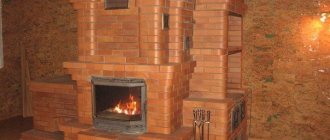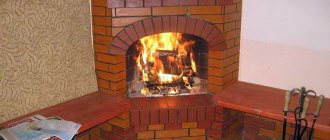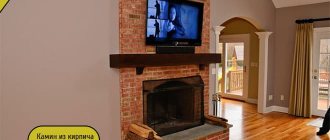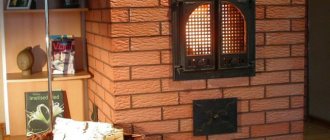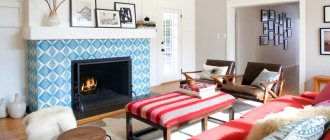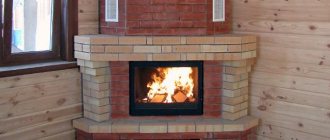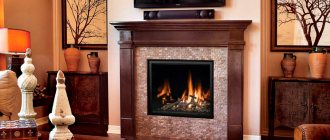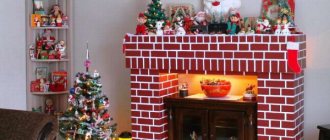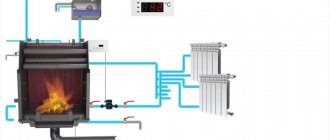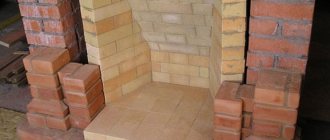Having a working fireplace in your own home is prestigious, convenient and, in a sense, even romantic. Few people will refuse to build it at their dacha or in a private country house. This article tells you how to build a fireplace at home with your own hands.
You can build a fireplace in almost any residential space - in a private house, in a country house, and even in an apartment located within a city high-rise building. The most important thing is to choose the right variety, as well as the design of this useful and aesthetic structure.
The design of the structure is selected depending on what function this object will perform in your home. After all, it can be either an effective structure for heating a home or simply a decorative decoration that creates the illusion of a living hearth.
Types of home fireplaces according to their location
According to the method of their location, fireplaces are divided into several varieties.
A built-in fireplace is a structure made in a niche of a load-bearing wall. This is the only variety that should be created at the stage of building a house. It is initially included in the main design of the building, has a powerful chimney, saves room space and guarantees powerful heat transfer. With the help of such a device you can heat a room of impressive size in bad weather.
A wall-mounted fireplace is the most common type. Its structure is located separately from the wall, and its chimney is attached directly to the wall. It is created after the construction of the house (after its owner wants to feel like an English aristocrat and enjoy the crackle of burning logs while sitting in a rocking chair).
A corner fireplace is an object located in the corner of a living space. Its unusual location gives a special charm to the surrounding environment. This design is quite simple, and its chimney is similar to the chimney used in wall-mounted fireplaces. The chimney is located near one of the load-bearing walls, pressing its back wall against it.
A free-standing fireplace is also called a central fireplace. It is located in the interior space of the room, and its chimney is in no way connected to the supporting structures. Such a structure looks very original, and several people can comfortably fit around it.
The design of all of the listed varieties provides for the arrangement of an open firebox. Regardless of the method of arrangement, all fireplaces have approximately the same layout and contain the same elements. Fundamental differences between them can only arise when a water heating circuit or underfloor heating is built into the design. But this issue requires separate consideration, because its topic is more inclined to the correct arrangement of modern heating systems.
Calculation part before installation
It is necessary to begin the construction of a brick fireplace by carrying out calculations. The equipment should perform not only a decorative, but also a practical function: maintain a comfortable microclimate in the room. It is necessary to prepare a drawing of the fireplace, focusing on the dimensions of the room.
It is not practical to install a large structure in a small room. During the combustion process, it will consume too much oxygen.
If there is a supply ventilation system, this will cause strong drafts. The second problem will arise in the excessive release of thermal energy. When the fireplace is working, it will be uncomfortable to be in the room.
In the process of engineering calculations, it is necessary to focus on determining the following parameters:
- design dimensions;
- its height;
- chimney sections.
Fireplace foundation
Like any construction, creating a fireplace begins with arranging a reliable foundation. When creating it, you should take into account the fact that the fireplace has a fairly massive structure and its weight can reach several hundred kilograms.
RNikonovForumHouse user
The depth, dimensions and other features of the foundation depend on the design. The issue is not heating, but the heavy weight of the fireplace and chimney. Therefore, under a fireplace over 200 kg, either a widening of the strip or a separate massive foundation is poured to the same depth as the strip.
In the case when the foundation for the fireplace is poured simultaneously with the foundation for the house, these two elements are strictly forbidden to be combined with each other. After all, uneven shrinkage of the walls of the house and the fireplace itself can lead to distortions and cracks. Between the foundation for the fireplace and the main strip, a small gap should be left (the width of the formwork), which should subsequently be filled with sand.
The foundation is created on the basis of concrete mortar. It can be strengthened by installing a grid of metal reinforcement in the dug pit. A rubble concrete pad is created as a base. This is also an acceptable option for a foundation that is poured in layers. Regardless of the type of foundation, a sand cushion 5...6 cm thick should be created at the bottom of the pit, on top of which a thin layer of crushed stone should be poured.
The area of the foundation should be such that the monolith protrudes beyond the perimeter of the fireplace by 100...150 mm on each side. The lower plane of the foundation should be 150...300 mm below the finished floor.
SeamouseFORUMHOUSE User
A 1x1 meter foundation has been cast for the future fireplace (it is not in the very center of the room, but it is not adjacent to the walls either). Now the foundation level is 280 mm below the finished floor.
After creating waterproofing, the base of the fireplace is raised to the floor level using a reinforced screed.
How the project is prepared
Some dimensions of the stove directly depend on the volume of the room that will have to be heated. Therefore, basic knowledge of geometry will form the basis of the tools when preparing the project. The volume of the room is calculated as the product of its linear dimensions. The niche for installing the firebox in the stove must have an area, to find which you will have to divide the area of the room by 50. Then the niche is modeled taking into account the proportion length/width = 3/2.
Ready-made version of an outdoor fireplace complex
If the area of the combustion hole allows certain errors to be made, then its depth is calculated as accurately as possible. After all, excessively large parameters will lead to heat loss and release into the chimney, and small ones will lead to a lack of proper draft. The depth of the niche for the firebox will be 2/3 of the height of the hearth. As you can see, all parameters are calculated sequentially and depend on each other. An error in calculating one size will result in a fatal error for the entire project.
Today, all conditions have been created for beginning developers. On some resources you can find ready-made tables that indicate the parameters of the fireboxes, depending on the area of the room or the total area of the house.
The area of the smoke duct, which will determine the parameters of the future chimney, deserves special attention. Even if you are doing your own development, it is still recommended to turn to a professional for these calculations. The presence of reverse draft or its overturning depends on the correct construction of the chimney. Correcting these shortcomings when the finished fireplace is already smoking is much more difficult than preventing them.
The next stage will again delight the novice master with calculations. A correctly calculated amount of building material leads to rational use of money. But for such arithmetic operations, it is necessary to have a ready-made drawing in front of your eyes, from which you can clearly estimate the number of bricks used. It is important not to forget that two layers of brick are often used for laying walls. When purchasing material, its quantity must be increased by 10% of theoretical indicators. Thus, we will be able to cover various types of rejections.
BBQ oven arrangement diagram
Design and calculation
Before building a fireplace, it is necessary to develop a suitable design for this structure. In principle, for your own needs you can order a project from a specialized organization. But if you want to make a fireplace with your own hands from start to finish, then the design should also be done on your own.
Each fireplace has several mandatory elements in its design:
- Portal.
- Cornice.
- Protective area in front of the firebox (fireplace table).
- Under.
- Firebox.
- Grate.
- Ash pit (ash pan).
- Back plate.
- Smoke chamber.
- Smoke tooth.
- Chimney.
A lining is created in the internal space of the firebox - a special finish made of refractory materials (the role of the lining may well be played by refractory bricks).
Calculating the main dimensions yourself is not difficult. In most cases, it is enough to know the area of the room in which the fireplace is installed. Using the table below, this can be done quite quickly.
For fire safety purposes, the bottom plane of the firebox should be designed so that it is at least 30 cm above the floor level.
The lower part of the fireplace with a grate is shown in the diagram. The ash pan can be made completely open so that air can freely penetrate into the combustion chamber. But for fire safety purposes, it is better to install a special door at the entrance to the lower chamber.
The fashionable trend today is to buy ready-made fireboxes. The range of these products is truly huge, and their purchase will be justified. After all, installing a finished firebox greatly simplifies the design and calculation of the fireplace. The combustion chamber with a built-in ash pan can be installed on a special brick pedestal (30 cm high), and the space created below can be used for storing fresh logs.
Additional items
In addition to the listed parts, other parts are also involved in the design of the fireplace:
- Grate. In other words, this is a grate that is located at the bottom of the firebox and is used to lay firewood on it. Thanks to the installed grates, uniform combustion of the fire is achieved due to the supply of air.
- Blower. It is located at the bottom of the device and serves to supply the chimney with sufficient draft. Its second purpose is air access to the grate.
Fireplace elements - Ash pit. This is a chamber located under the grate, designed to collect combustion products, which is why it is installed in wood heating devices. In some models, this element acts as a blower.
- Smoke collector. It is located in the lower part of the structure and is designed to perform the functions of an exhaust hood, which is located above the firebox. Its main purpose is to ensure the removal of combustion waste into the chimney, preventing it from penetrating inside the house.
- Damper or gate. It is located in the pipe slightly above the smoke collector. When the fireplace is not working, the damper closes the chimney, providing protection against hot air escaping outside. In addition, the gate helps regulate the traction force.
Fireplace masonry
Fireclay bricks should be used for the interior lining of the fireplace. It withstands high temperatures well and demonstrates high durability.
It is unacceptable to use hollow bricks in the structure. After all, such material quickly collapses and poorly transfers heat coming to its surface from the internal space of the firebox.
For external cladding, red ceramic bricks should be used (grade no lower than M200).
yanka FORUMHOUSE user
The stove gives off heat precisely from the outer bricks, which can heat up to decent temperatures, and only solid red brick can be used during the construction of fireplaces. The voids simply greatly weaken the brick, and silicate brick generally releases all sorts of nasty things when heated.
The masonry mortar must be prepared using fireclay clay and quartz sand. It is better to immediately throw the option with cement mortar out of your head. After all, nothing more destructive, awkward and unacceptable than cement mortar used in the composition of the fireplace masonry can be imagined. Fireclay clay is sometimes called kaolin, and this ingredient is sold in most hardware stores.
Vladimir A FORUMHOUSE user
Not cement, but fireclay clay. Now there are a lot of different ones on sale - for every taste and even color! There is no significant difference in quality between them.
Masonry begins with the creation of a basement row. The first row of bricks is always placed on edge, and the rest should be laid flat.
Before starting work, the brick used must be immersed in water for a few minutes. This will significantly increase the strength of the structure, because moisture from the mortar will not be absorbed by the surface of the bricks.
Before you start laying the fireplace, you need to create an order that matches the existing project. Further construction must be carried out in strict accordance with the order:
- pedestal;
- firebox (starting from the 4th row);
- cornice and so on.
Chimney installation
After the “body” of the fireplace is ready, you can begin creating the chimney. Its passage must correspond to the calculated value. The top of the chimney should be reliably protected from precipitation. For these purposes, you should use a wide smoke hood made of galvanized sheet metal.
There is no better material for a chimney than red ceramic brick. Here's what one of our forum participants thinks about it.
vinogradovskiyFORUMHOUSE user
The advantages of a brick chimney are considerable. It is much more difficult to achieve the formation of condensation in a brick pipe than in a sandwich - you have to try. The combustion of soot is not dangerous; the heating of the outer surface of the pipe in the attic is minimal or even completely unnoticeable. The durability of a properly laid brick pipe is many decades.
As a chimney, you can use a galvanized pipe made of heat-resistant steel. Such a chimney is made multi-layered (the result is a kind of “sandwich”), and it is covered with plasterboard on three sides.
During periods when the fireplace is inactive, any chimney becomes the cause of drafts. In order to avoid such a harmful phenomenon, special valves (gates) are installed in the chimney shaft. They open only when the firebox “comes to life”, filling the room with pleasant warmth.
The cross-sectional area of the cylindrical chimney with the area of the fuel portal should have a ratio of 1:10.
Particular attention should be paid to the height of the outer part of the chimney:
- if the distance from the ridge to the chimney is less than 1.5 m, then the chimney must be at least half a meter higher than the ridge;
- if the distance from the chimney to the ridge is more than 1.5 m, then the upper cut of the chimney should not be lower than the level of the ridge.
Fireplace design
The design should fit the overall style of the interior. And if high-quality and aesthetic bricks were used during construction, then in order to give the fireplace a complete appearance, a minimum of effort will be required. It all depends on the owner’s imagination. In relation to the fireplace, you can apply bold design solutions using a wide variety of materials. It can be tiles or natural stone, marble or tiles. The main thing is that the materials have fire-fighting properties and do not collapse under the influence of high temperatures.
AngarchaninFORUMHOUSE user
Heat transfer through ceramic tiles, just like through tiles, only increases (the density of the material is higher). Warm infrared radiation is initiated from the surface of the glaze and from the sintered underglaze part of the clay slip, when heated to 35 degrees or higher. It is much more intense than from the surface of a brick. Facing with tiles or porcelain stoneware will definitely provide benefits.
By purchasing special kits for fireplaces, you can qualitatively improve the appearance of these structures. Indeed, the package of such a purchase, in addition to the required accessories (brushes, tongs, poker, etc.), includes a large number of additional stands and decorations that can significantly transform the appearance of the home.
If you want to use a home fireplace as a decorative home heating system, then you simply need to visit the forum section dedicated to the construction of a fireplace stove. You can find out what you need to consider when choosing a fireplace insert in the corresponding FORUMHOUSE section. You can share your experience and get practical advice regarding the construction of a chimney for a home fireplace in the section “Choosing a chimney for a fireplace stove.” Also, an interesting video is available for all visitors to our project, which will help you decorate your home fireplace with high quality.
Rules for operating a barbecue oven
A few basic rules for its operation will help extend the life of a brick outdoor stove.
- A sufficient amount of air must enter the firebox, which will ensure complete combustion of the fuel and will not allow a large amount of soot to settle on the walls.
- The oven damper must be open.
- It is better to heat the stove with hardwood wood.
- It is recommended to use special equipment for cooking.
A well-equipped recreation area, the center of which will be an outdoor barbecue oven, will not only allow you to have a wonderful time in the fresh air and prepare healthy dishes. It will be a great addition to any area.
